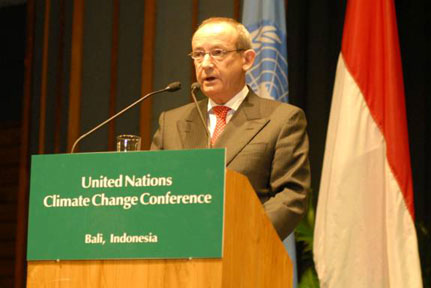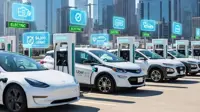Bali Roadmap – Giving direction to an endangered world
By Sourya Biswas | 22 Dec 2007
We have already talked about the perils of climate change due to global warming, and the splendid efforts by Al Gore and Leonardo DiCaprio to convince their disbelieving countrymen of the impending dangers to mankind at the hands of mankind itself (See: Al Gore speaks an Inconvenient Truth (Part 2)).
 The three-part series that we carried coincided with the 2007 United Nations Climate Change Conference that took place at Nusa Dua, in Bali, Indonesia, between 3 December and 15 December 2007. The common intent of this meeting attended by representatives of 187 nations was to decide on a successor to the Kyoto Protocol, which is set to expire in 2012.
The three-part series that we carried coincided with the 2007 United Nations Climate Change Conference that took place at Nusa Dua, in Bali, Indonesia, between 3 December and 15 December 2007. The common intent of this meeting attended by representatives of 187 nations was to decide on a successor to the Kyoto Protocol, which is set to expire in 2012.
Amidst loads of global posturing, some common ground, and a few acrimonious arguments, participants of the UNFCC conference adopted a general framework of steps to work towards a binding agreement at the next global summit scheduled for 2009 in Denmark. This framework has been popularly titled the ''Bali Roadmap''.
Background to the Bali Roadmap
A discussion on the Bali Roadmap will be incomplete without a small background on the agreement it seeks to replace, not because of its inadequacy but because of its limited lifespan - the Kyoto Protocol.
The Kyoto Protocol is a set of rules that was created with the stated objective of reducing greenhouse gases that cause climate change. It itself replaced, or rather, updated, an earlier treaty called the United Nations Framework Convention on Climate Change (UNFCCC or FCCC), which was tabled at the United Nations Conference on Environment and Development (UNCED) at Rio de Janeiro in 1992, a conference which has come to be popularly known as the Earth Summit.
The Kyoto Protocol was agreed on 11 December 1997 at the 3rd Conference of the Parties at Kyoto, after the groundwork had been done at two previous conferences at Berlin and Geneva, and entered into force on 16 February 2005. The protocol required 36 developed countries to reduce greenhouse gas emissions to levels prior to that of certain years as individually specified. The developing countries are required to monitor and report emissions, but are not bound to reduce them.
The apparent 'free lunch' given to developing countries has always been a bone of contention with the developed countries, with the result that the United States and Australia until only recently, had not ratified the treaty. Even those who have ratified have done so grudgingly. As we had already pointed out in our earlier series, ''What many fail to realize, or perhaps consciously ignore, is that even after implementing Kyoto Protocol norms, the carbon footprint per capita would be thrice for the US than it is for India. Currently, it is twenty times as much''.
Taking-off from the Kyoto Protocol
As with all global treaties, the Kyoto Protocol too comes with an expiry date – 2012 as a matter of fact. So it was felt necessary to start proceedings to an agreement that would replace the Kyoto Protocol when the time came. Accordingly, the participating countries agreed on the Bali Roadmap as a two-year process to work towards a treaty acceptable to all.
''We now have a roadmap, we have an agenda and we have a deadline. But we also have a huge task ahead of us and time to reach agreement is extremely short, so we need to move quickly,'' said Yvo de Boer, executive secretary of the UNFCCC, at the conference. Indonesian environment minister Rachmat Witoelar, who presided over the conference, echoed his words.

Secretary of United Nations Framework Convention on Climate Change (UNFCCC)
Yvo de Boer inaugurates the United Nations Climate Change Conference at Bali
One of the biggest achievements of the conference was the unanimous decision of the participants to acknowledge that evidence of the earth's warming is ''unequivocal'', and that delays in reducing emissions increase the risks of ''severe climate change impacts''.
The roadmap includes pledges from the countries to protect and preserve forested areas through ''policy approaches and positive incentives'', as well as promises of funds to the World Bank to initiate pilot projects under the banner of Reducing Emissions from Deforestation in Developing countries (REDD).
The size limit for small-scale reforestation projects is to be doubled to 16 kilotonnes of carbon dioxide per year, to enable more projects to qualify for the UN clean development mechanism (CDM), with inclusion of carbon capture, sequestration and storage as a CDM activity being discussed for the first time.
The roadmap lays down duties for both developed and developing nations. While the developed countries are required to take on commitments that are ''measurable, reportable and verifiable'', and ''nationally appropriate'', the developing states are encouraged to use advanced technology from developed nations to perform ''measurable, reportable and verifiable actions" in the context of sustainable development.
Thus, even while there is agreement on the predominant role played by industrialised nations in having polluted the earth's atmosphere in the past, the developing nations have not been completely exempted from responsibility in light of past history but have been asked to do their part.
Of course, that is conditional to aid, both economic and technical, from the developed nations.
The roadmap lays great stress on technology transfer for reducing emissions and mitigating the effects of global warming, and pledges to consider how to ''remove obstacles to, and the provision of financial and other incentives for, scaling up'' the transfer of clean energy technologies from industrialised nations to the developing world.
Governments also agreed to kick-start a strategic programme to scale up investment for the transfer of both adaptation and mitigation technologies to developing countries, and also develop an environment conducive to investment in this sector by providing incentives.
The roadmap recognises the enhanced potential for natural disasters in the light of climate change and resolves to consider ways of reducing their occurrences and damages. In this context, mechanisms were formulated for governing and administering the Adaptation Fund to help poor countries cope with climate change.
''The roadmap that has been agreed is a pivotal first step toward an agreement that can address climate change risks to our planet, the defining challenge of our time'' said UN secretary-general Ban Ki-Moon, with particular stress on adaptation measures, technology transfer and combating deforestation. He said he ''appreciates the spirit of cooperation shown by all parties to achieve an outcome that stands to benefit all humanity''.
Hammering out an agreement
However, coming to an agreement wasn't easy. ''Fourteen days of negotiations, running deep into midnight on several occasions, finally brought us to the showdown on Friday night,'' one Indian delegate said from Bali. It was only when the US delegation got down from its narrow position that the final agreement for the Bali Roadmap emerged. The rigid US stance had so angered the other participants that the representative from such a small nation as Papua New Guinea had the courage to berate US officials. ''If you cannot lead, leave it to the rest of us. Please get out of the way,'' said the visibly angry Kevin Conrad to widespread applause.
The main cause of dispute was a single paragraph in the section on the future role of developing countries to help reduce the emission of greenhouse gases, and this caused the conference to extend by an unscheduled day to 15 December instead of concluding on 14 December as previously agreed. The wording of the paragraph was changed overnight to reduce emphasis on technology transfer, even after a draft had been shown, and accepted, by the developing countries headed by India and China. This led to hectic negotiations before the draft was revised and the Bali Roadmap finalized.
Amidst all the celebrations surrounding this act of international cooperation, one shortcoming needs to be pointed out. While the developing countries had insisted on setting targets for emission cuts, and had been supported on moral grounds by the European Union, this had to be abandoned in the face of US pressure.
In the end, although no specific cuts were agreed upon, the Bali deal did succeed in setting a timeline and an agenda for future discussions that may finally obtain for the developing world funding from the richer nations as well as technology transfer, providing the encouragement for greener development.
India was represented at the conference by science and technology Minister Kapil Sibal, who insisted that India was ''absolutely'' able to sustain its position on global warming issues. He attributed the unity of the developed nations to the newfound camaraderie between India and China, and said that the ''foundation'' of the ''road map'' was the ''unity of the Group of 77'' of developing nations.
The implementation of the Bali Roadmap has been kicked off on a war footing, with initial member views being sought as early as February 2008, with the first meeting scheduled soon after. Three other meetings are scheduled for next year, with the fourth and largest at Poznan, Poland in December 2008. The entire process of converting the roadmap into a viable treaty is to be finalized by the 2009 UN summit scheduled at Copenhagen, Denmark.


.webp)



















